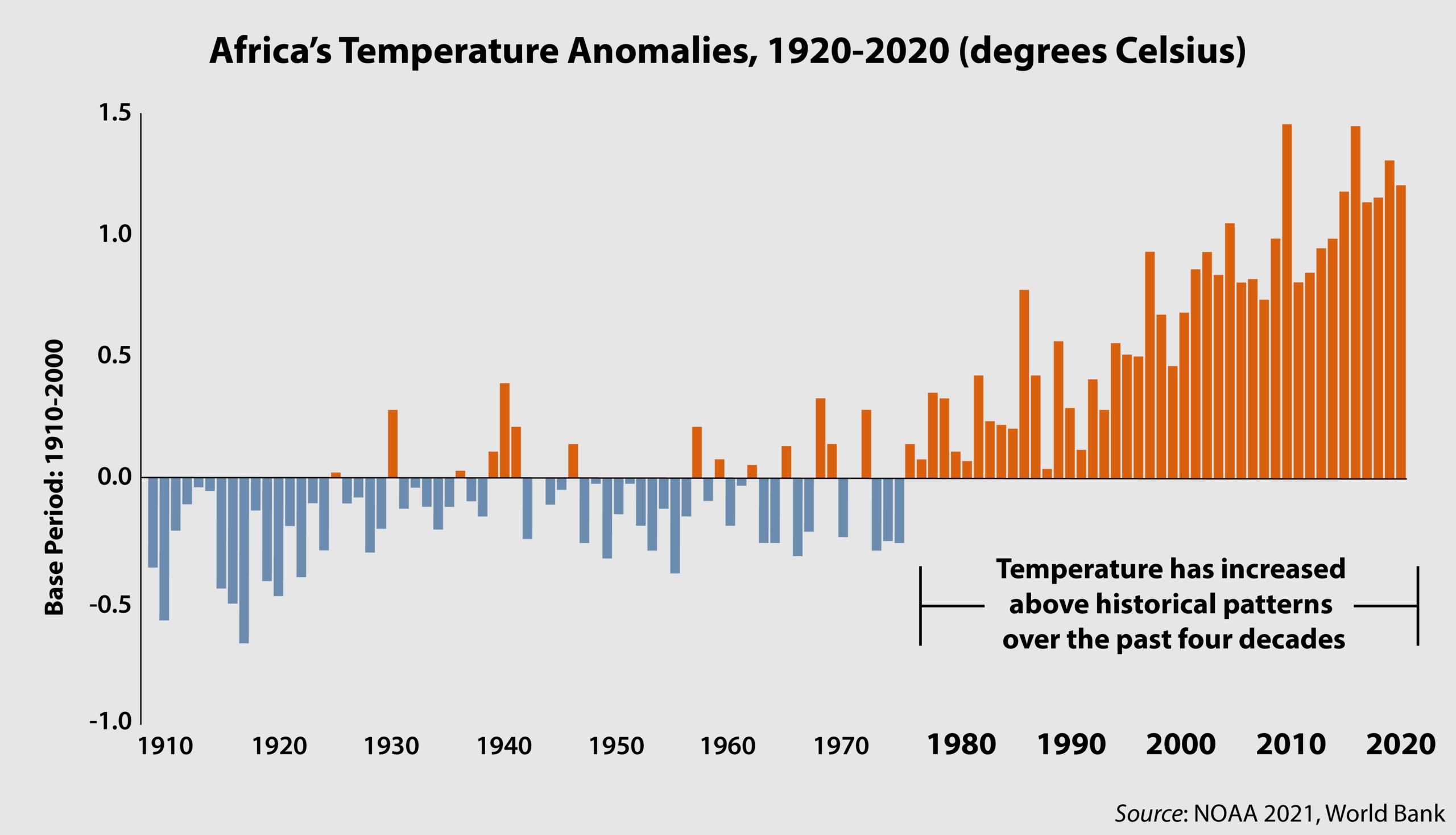Global warming is contributing to more and extended heat waves, a tripling of droughts, a quadrupling of storms, and a tenfold increase in flooding in Africa since the 1970s—exacerbating security threats on the continent.
More Frequent and Longer Lasting Heat Waves
The last decade was the warmest on record, part of a multidecade trend. Last year, the average temperature for Africa hovered around 1.2°C above the 1981-2010 average.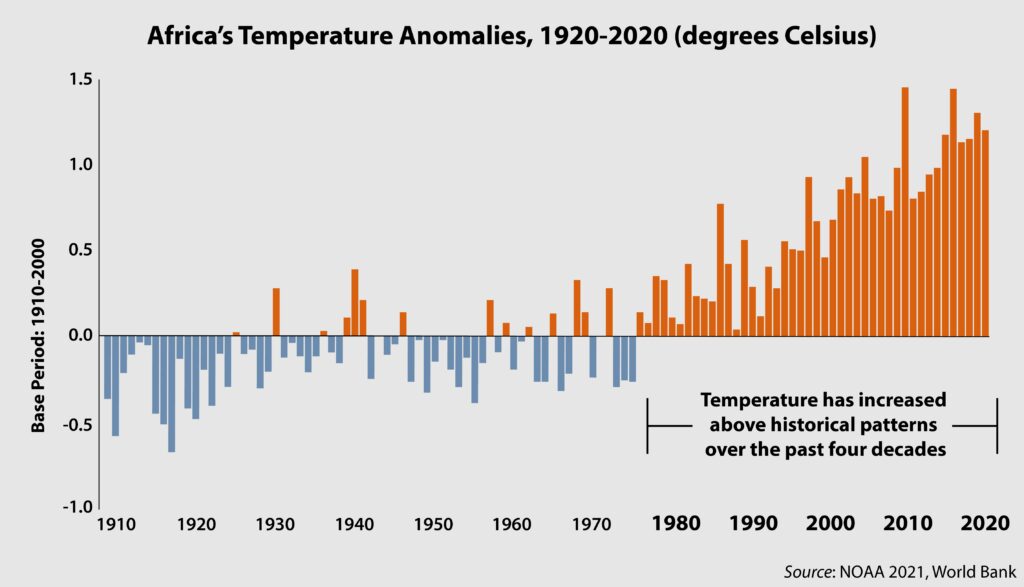
African countries within 15 degrees of the equator are projected to experience an increase in frequency of heat waves. In Central Africa, Cameroon, Equatorial Guinea, Gabon, the Republic of the Congo, and the coastal areas of northern Angola and DRC, already see on average 8-10 heat waves per year. In East Africa, Uganda, Ethiopia, and Kenya—and the Atlantic coast of South Africa—are also experiencing an increasing frequency of heat waves.
A 0.5°C increase in temperatures can lead to a 150-percent increase in the number of heat waves that kill 100 people or more.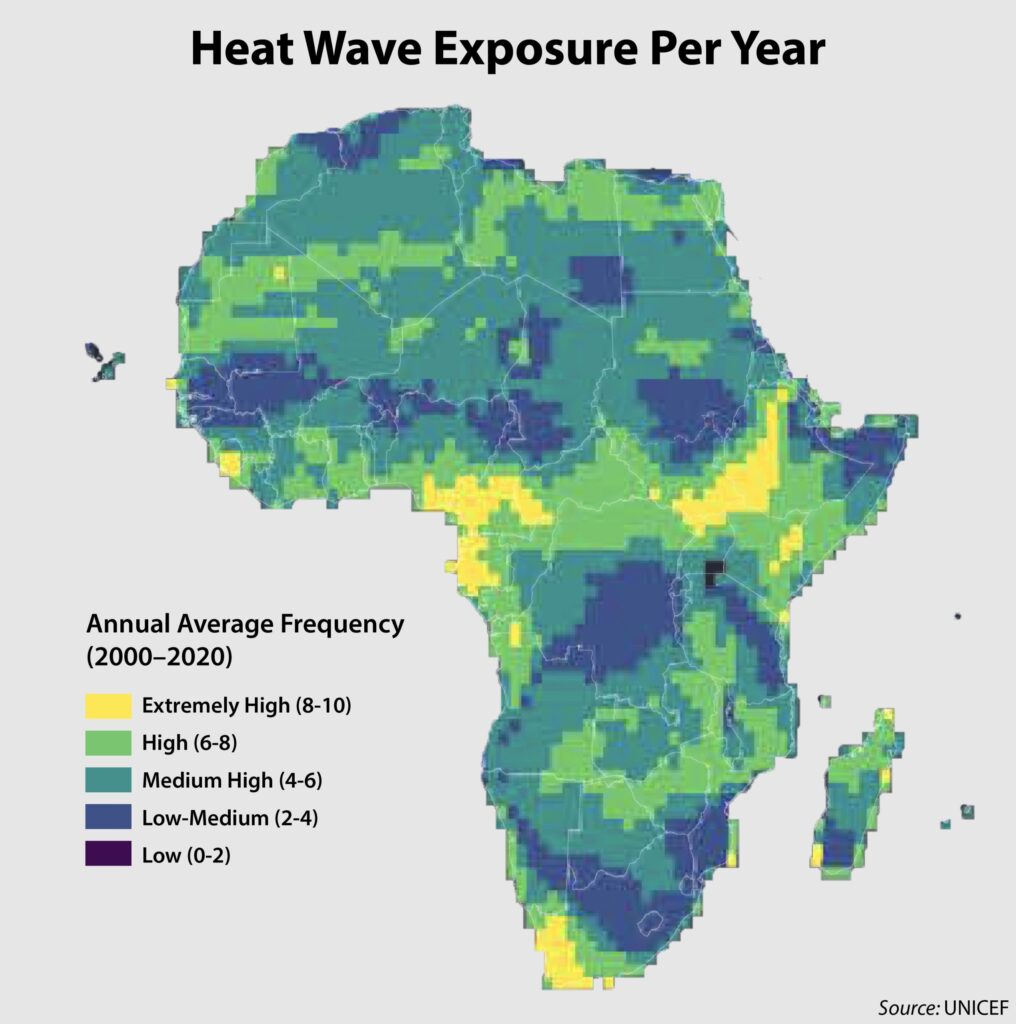
Other Extreme Weather Events
According to the Intergovernmental Panel On Climate Change (IPCC), human-created global warming has caused an increase in extreme weather events—from heavy rainfall causing flooding and stronger storms in equatorial countries and parts of East Africa—to increased drought in the Sahel and southern Africa.
The incidence of natural disasters in Sub-Saharan Africa has increased at a faster pace than the rest of the world. Compared to the 1970s, the frequency of droughts has nearly tripled, storms have quadrupled, and floods increased tenfold. As a result, 20 percent of the floods and more than one-third of the droughts recorded globally over the past decade have been in Sub-Saharan Africa.
Africa’s only three mountains with glaciers, all in East Africa, will likely see “total deglaciation” by the 2040s—Mt. Kenya perhaps a decade earlier.
At a 2°C increase, southern Africa is set to become 5 to 10 percent drier as increasing drought frequency and number of heat waves cause reductions in the volume of the Zambezi Basin. According to Professor François Engelbrecht, one of Africa’s leading climatologists, “Multi-year droughts are the number-one climate change risk that South Africa faces in a changing climate.”
At a 3°C increase, the western Sahel region is expected to experience the strongest drying, with a significant increase in the maximum length of dry spells. Central Africa would see a decrease in the length of wet spells and an increase in heavy rainfall.
Global Warming is Expected to Amplify Multiple Security Risks in Africa
Reduced Food Production
A 1°C increase in temperature is associated with a decline in agricultural output of 2.7 percentage points. The impact will be especially severe in Africa where many households depend on weather-sensitive activities, such as rain-fed agriculture, herding and fishing, for their livelihoods.
Biodiversity losses and ecosystem degradation as a result of drought and unpredictable rainfall will affect the quality of the soil and vegetation.
Increased incidents of floods will continue to negatively affect agricultural livelihoods (e.g., through seed loss, crop damage, and livestock morbidity and mortality), leaving communities more vulnerable.
Under a warming of 2°C, the World Bank forecasts a 10 percent decrease in crop yields across Sub-Saharan Africa by the 2050s.Land Pressure and Displacement
Intensification of production on existing agricultural lands to fill “yield gaps” is a threat to the environment through the potential overuse of regional water resources and ecosystems. Likewise, the expansion of agriculture into “new” lands often threatens local and regional ecosystems.
Growing land pressure can lead to displacement and the escalation of existing tensions between communities.
Lake Chad—which is a lifeline for some 30 million people in Chad, Niger, Nigeria, and Cameroon—has shrunk by over 90% since the 1960s due to climate change, a growing population, and unmanaged irrigation. Evaporation of the lake has only accelerated as it gets shallower. The loss of livelihoods has coincided with increased criminality and migration to urban centers.
There are an estimated 18 million seasonal migrant workers in Africa, of which 80 percent work in sectors such as agriculture, mining, and fishing. Deteriorating climate conditions have turned seasonal migration into an ineffective strategy for many, however, and is one of the contributing factors to more permanent migration and displacement.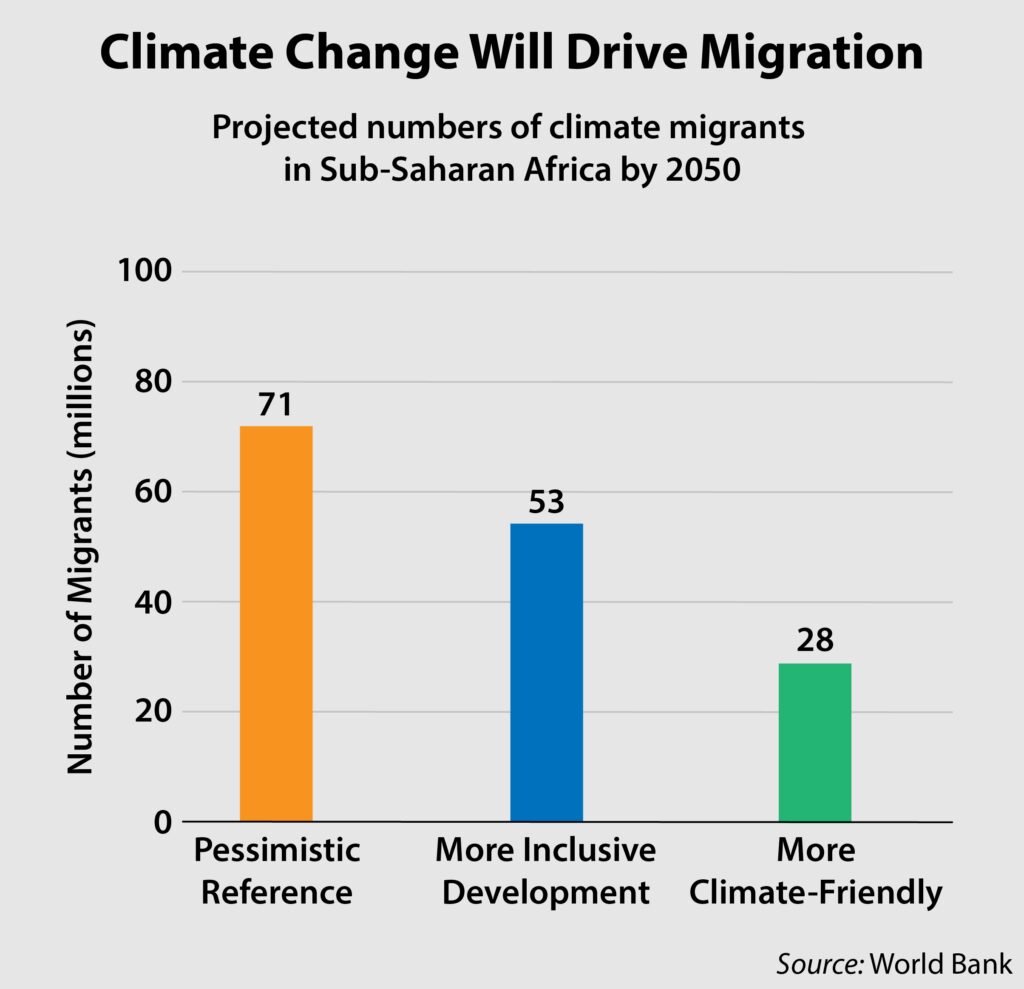
In the worst-case global warming scenario, Sub-Saharan Africa would see up to 86 million people moving within national borders. North Africa would make up the largest proportion of those climate migrants, with 19.3 million people moving, equivalent to roughly 9 percent of its population, due mainly to increased water scarcity.
As a result of lower crop yields, reduced agricultural and labor productivity, and declining human health, climate change is projected to have a compounding negative impact on Africa’s economic well-being over time.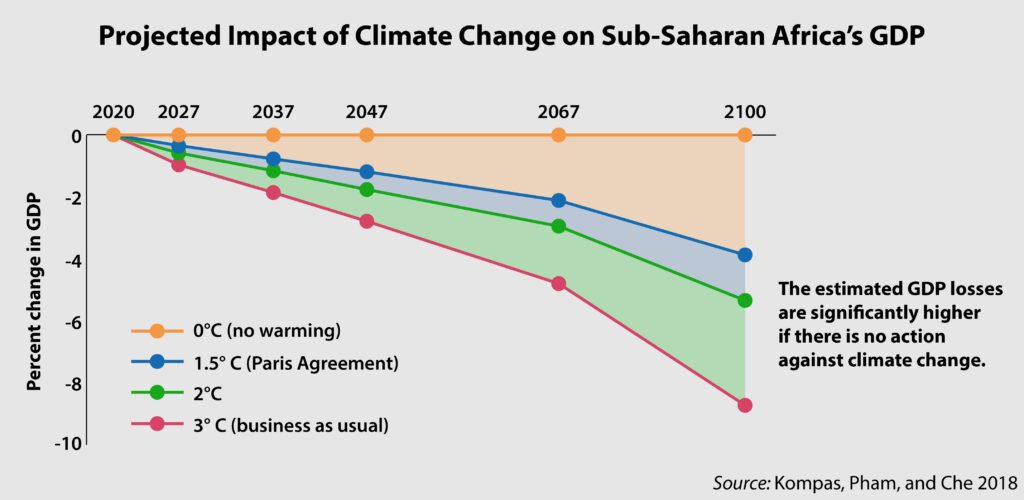
Conflict
Of the 20 countries deemed most vulnerable to climate change according to the ND-GAIN Country Index, 17 are African. Of those African countries, nine are experiencing conflict. While most analysts agree that global warming does not cause conflict, many have stressed that it acts as a “crisis amplifier and multiplier” which can increase tensions around access to resources, food, and ancestral lands. In places where there are sociopolitical disparities, weak rule of law, and frayed social cohesion, these tensions can lead to conflict.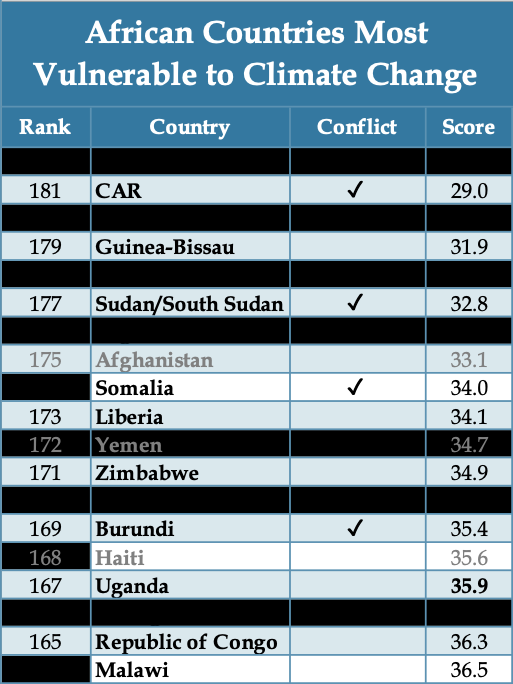
Priority Actions Needed
There is insufficient climate data collected from Africa. Generating more comprehensive and accurate data will lead to more informed and better tailored approaches to adapting to global warming impacts.
Agriculture employs a majority of Africans and can absorb large numbers of relatively unskilled workers. The agricultural sector, therefore, is a critical link between climate change and security. In addition to adapting more drought-tolerant seed varieties and practices, greening the productivity of small-holder farming and strengthening property rights and land access rights are vital.
With intra-African migration expected to continue increasing, efforts to create more and safer migration opportunities are needed for those looking for alternative livelihoods.
To defuse potential increases in intercommunal conflict related to growing land pressure caused by climate change, governments and intermediary reconciliation committees should proactively encourage dialogue between farmer and herding communities so as to enhance mechanisms to handle disagreements and mitigate conflict escalation. Governments will also need to review grazing and land rights—and take an even-handed approach to enforcement.
